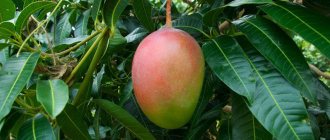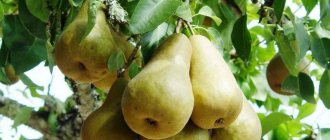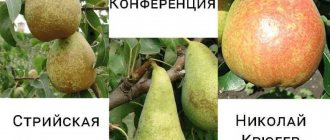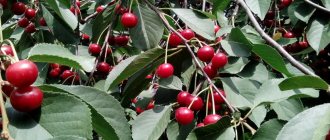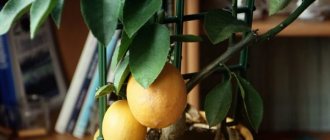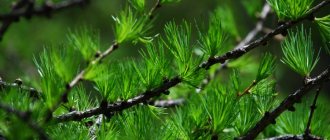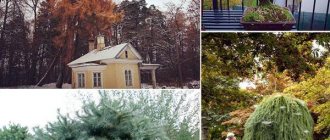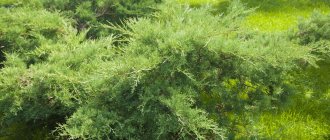It’s hard for residents of the middle zone to believe, but about 40% of the trees in Russian forests are larches. There are especially many of them in Eastern Siberia and the Far East. Under natural conditions in our country, larches (Larix) of Sukachev, Siberian, European, Daurian, Kuril, Olga, as well as several hybrid forms grow - Amur, Chekanovsky, Lyubarsky, Okhotsk. In cultivation, the most common species is Japanese larch, or Kaempfer.
Externally, all larches are very similar: they are large trees (up to 50 m) with wide-conical crowns, but there are also dwarf varieties. The needles are soft, narrow, straight or slightly curved, collected in bunches of 20–60 pieces. Like all conifers, larches are durable.
In early spring, thin branches are covered with thick brushes of tender young needles. Then, against their background, female cones (reddish, pink or green) and male spikelets (yellow) appear. Light blows of wind lift clouds of golden pollen above the tree, and self-pollination occurs. The cones ripen in late August - September, but open more often at the end of winter. They are small and woody; the seeds are winged, the wind carries them far from the mother trees. It is curious that, having given up the seeds, the cones fall off.
In autumn, larch needles take on shades from pale lemon to bright yellow and golden orange.
- Ornamental larch cultivars European larch (Larix decidua) Horstmann Recurved
- Kornik
- Pendula
- Puli
- Repens
- Pendula
Description of larch and use in landscape design (with photo)
All types of larches are similar in appearance to large deciduous trees with horizontal, widely and unevenly spaced, and sometimes hanging branches. The first thing worth noting when describing larches is the strength of the trees and their branched root system. They will grow up to 50 m in height. Some specimens live to be five hundred years old or more. The bark is roughly wrinkled and thick. The needles are needle-shaped, flat, thin, soft, light green or bluish. Male “flowers” are single, rounded or ovoid, formed at the ends of short leafless shoots.
As you can see in the photo, the cones of the larch tree are small, oblong-ovate, young ones are green or purple, mature ones are gray-brown:
The seeds ripen and fall out in the first year, but the cones remain on the branches for several years. The percentage of fully developed seeds is small, and their germination capacity disappears in the 2-3rd year.
The larch tree is one of the most valuable industrially. The active use of wood has led to a significant reduction in the European distribution area. If in the 12th century there were vast larch forests even in central Russia, now this tree begins to dominate the forests only starting from Siberia.
All types of larches are equally valuable for garden decoration. As a rule, they are planted as tapeworms (attractive single specimens) or created into backstage groves.
Look how beautiful the compositions with larches in landscape design are in these photos:
Against the background of deciduous larches, evergreen pines, spruces and firs look impressive. Joint planting of coniferous larch trees with the addition of deciduous trees is the main theme of classic park compositions of northern gardens. Larches can easily tolerate pruning, but are not suitable for topiary. To form a compact crown, it is possible to trim large twigs and branches in early spring or autumn, as well as shortening young growths, which causes active tillering and compaction of the crown. Young larches are flexible, elastic plants, and this allows them to bend their trunks and branches, intertwine the branches and, by fixing them on a support, change the type of their growth. By using this method and combining it with pruning, you can create “living” arches, pergolas and gazebos using larches in landscape design.
The following describes what different types and varieties of larches look like.
Features of reproduction
You can propagate a tree in various ways:
- By layering.
- Seeds.
- By cuttings.
The first method is the simplest but most effective. Even under natural conditions, European larch often takes root by layering. To do this, at the end of spring, the lower shoot is fixed to the ground and the main part is sprinkled with soil and moistened abundantly. Water continues to be provided throughout the season. By autumn, roots will appear, after which the cuttings are given another season to develop. Then, towards the end of summer, it is carefully separated from the mother tree and planted in a permanent place.
Propagation of European larch by seeds is more labor-intensive, although this is also an effective method. To obtain seed, it is necessary to track the moment of opening of the cones. This can happen in both spring and autumn. The seeds are simply taken out of the axils, and in some varieties the scales have to be opened. Then they are kept in cool water for 4 hours and immediately planted in open ground (in spring) or stored in the refrigerator until planting (in autumn harvest).
Important! For the winter, the sprouts are mulched with leaves, sawdust, and covered with fiber.
The germination rate of European larch seeds is about 10%, so you need to sow a lot of grains
The third method of propagation is cuttings. New seedlings do not take root well, even if they are provided with comfortable conditions (humidity and greenhouse air temperature). Therefore, growing European larch from cuttings is practically not used.
Popular types and varieties of larch: photos and descriptions
Widely popular in cultivation and absolutely frost-resistant are European larch (L. decidua), Gmelin larch (L. gmelinii), American larch (L. laricina).
Larix decidua - Deciduous larch, or European larch.
It grows in the mountains of Central Europe, occupies large areas and reaches the level of alpine meadows. It has many cultivars of different habitus and growth type.
Recommended varieties of European larch:
Larix decidua Compacta.
A dwarf variety of European larch. The branches are densely pubescent, the needles are soft and green. Annual growth is within 10-12 cm. The autumn color of the needles is from golden to dark orange. Completely frost-resistant. The autumn color of the needles of this variety of European larch ranges from golden to dark orange. Completely frost-resistant.
Larix decidua Lucek.
Medium-sized variety of European larch. The branches are erect. The needles are golden in spring, pale green at the end of summer. Annual growth is 30-50 cm. The autumn color of the needles is from golden to dark orange. Completely frost-resistant.
Larix decidua Pendula.
A weeping variety of European larch. The branches are densely pubescent, cascading, brittle.
Pay attention to the photo - the needles of this larch variety are soft and green:
Annual growth is up to 70 cm. The autumn color of the needles is from golden to dark orange. Completely frost-resistant.
Larix decidua Horstmann's Recurved.
Large-sized variety of European larch. The branches are twisted, growth is irregular, some of them are erect, others are drooping. Annual growth is within 50 cm. The autumn color of the needles is from golden to dark orange. When describing this larch variety, it is especially worth noting its high frost resistance.
Larix decidua Krejci Mutation.
A dwarf variety of European larch. Growth is irregular. The branches are densely pubescent, the needles are soft and green. Annual growth within 50 cm.
Larix decidua Pali.
A weeping variety of European larch. The branches are densely pubescent, cascading, brittle. The needles are soft and green. Annual growth is up to 30 cm. The autumn color of the needles is from golden to dark orange. Completely frost-resistant.
Larix gmelinii - Gmelin larch, or Dahurian larch.
It forms thick forests in the Far East, replacing a closely related species in Eastern Siberia, L. sibirica. In the highlands it has a curved shape and dwarf growth, which is used by gardeners to create dwarf bonsai trees. The needles are tender, green, slightly bluish. It has a few varietal varieties.
Larix laricina - American larch.
Forms large forests in the mountains of North America.
As shown in the photo, the needles of this type of larch are delicate, light green:
It has cultivars of different habitus and growth type.
Recommended variety of American larch:
Larix laricina Tharandf.
Mini variety of American larch. Round shape. The needles are gray-blue, soft. The autumn color of the needles ranges from golden to dark orange. Annual growth is 5-6 cm. Completely frost-resistant.
Larix kaempferi - Kaempfer's larch.
Grows in the mountains of the Far East. The needles are tender, bluish-green. It has numerous varietal forms with gray and blue needles. Widely used to create dwarf bonsai trees.
Recommended varieties of Kaempfer larch:
Larix kaempferi Blue Ball.
Dwarf variety of Kaempfer larch. The shape is round. The needles are soft and green. The autumn color of the needles varies from golden to dark orange. Annual growth of 10 cm. Completely frost-resistant.
Larix kaempferi Cruwys Morchard.
Almost indistinguishable from Larix kaempferi Little Bogle. The branches are whip-shaped, densely pubescent. The needles are soft, gray-green. The autumn color of the needles varies from golden to dark orange. Annual growth within 10 cm. Completely frost-resistant.
Larix kaempferi Cupido.
Dwarf variety of Kaempfer larch. The shape is round. The needles are soft, gray-green. The autumn color of the needles changes from golden to dark orange. Annual growth within 10 cm. Completely frost-resistant.
Larix kaempferi Diana.
Large-sized variety of Kaempfer larch. Spreading oval shape. The branches are curved, the needles are soft and green. The autumn color of the needles varies from golden to dark orange. Annual growth is more than 30 cm. Completely frost-resistant.
Larix kaempferi Gray Pearl.
Dwarf variety of Kaempfer larch. The shape is round. The needles are soft, gray-green. The autumn color of the needles varies from golden to dark orange. Annual growth is within 5-7 cm. Completely frost-resistant.
Larix kaempferi Little Bogle.
Almost indistinguishable from Larix kaempferi Cruwys Morchard. The branches are whip-shaped, densely pubescent. The needles are soft, gray-green. The autumn color of the needles varies from golden to dark orange. Annual growth within 10 cm. Completely frost-resistant.
Larix kaempferi Mazanek.
Medium-sized variety of Kaempfer larch. The branches are curved, whip-shaped, chaotically located. The needles are soft and green. The autumn color of the needles varies from golden to dark orange. Annual growth is within 30 cm. Completely frost-resistant.
Larix kaempferi Minor.
Medium-sized variety of Kaempfer larch. The branches develop in a vertical direction, whip-like. The needles are soft and green. The autumn color of the needles varies from golden to dark orange. Annual growth within 30 cm. Completely frost-resistant,
Larix kaempferi Stiff Weeping.
Weeping variety of Kaempfer larch. Oval-elongated shape. The branches are densely pubescent, cascading.
The width and height of the plant can be set by the gardener himself. The needles are green-blue. The autumn color of the needles ranges from golden to dark orange. Annual growth is within 50 cm. Completely frost-resistant.
Larix kaempferi Wehlem.
Dwarf variety of Kaempfer larch. The shape is rounded and flattened. The needles are soft, gray-green-blue. The autumn color of the needles ranges from golden to dark orange. Annual growth is 5-7cm. Completely frost-resistant
Look at the photos of larch trees described above:
Larix sibirica - Siberian larch.
Forms extensive forests in Siberia and the Far East. This is the most common plant in Russia. The needles are tender, light green. Unfortunately, it has practically no garden cultivars.
Below you will learn how to properly grow larch in the garden.
Selection of location and soil
The tree is characterized by good winter hardiness and rapid growth. The last factor should be taken into account when choosing a location on the site. Therefore, planting European larch should be well planned; it is worth considering whether the planted tree will create unnecessary shading for you in the future. It is believed that the plant is not particularly demanding of soil, but does not tolerate waterlogging at all. It will feel equally good on chernozem, calcareous and shale rocks, but the best option is loam with moderate moisture. The tree is resistant to air pollution, so it is often used in urban landscaping.
How to grow larch in the garden
When planting and caring for larches, do not forget that these are “freedom-loving” plants. Only in an open place do they acquire the characteristic spreading shape of the crown. In shaded places and in dense plantings they are of little decorative value.
Larches are undemanding when it comes to soil; both sand and clay can be used for maintenance when growing trees, but these crops still give preference to light, fertile, slightly acidic loams.
Adult specimens have a powerful, branched root system and do not need feeding. Young plants can be fertilized in the spring after the snow melts on wet soil with complex or combined mineral fertilizer, but in no case with fresh manure and feces.
When caring for larches, replanting should be carried out either in early spring before buds open, or in autumn after the leaves turn yellow. In this case, it is possible to deepen the root collar, although it is not advisable. Plants with actively growing shoots require pruning, take root poorly and take a long time to get sick, so replanting them is not recommended.
Young larches easily tolerate replanting; large ones can be replanted only after preliminary preparation, when a dense lump is formed as a result of repeated pruning of the roots. If the plant is planned to be replanted in the fall, then pruning is carried out in the spring; for replanting in the spring, the plant is prepared in the summer of the previous year. In the process of caring for transplanted larches, you need to follow the same rules as when growing other conifers - water abundantly, and when replanting in spring, you also need to spray until the tree takes root.
Mature larches are extremely drought-resistant. Young plants require sufficient watering during the period of active growth and are able to tolerate the proximity of groundwater, but for adult plants, waterlogging is detrimental.
Most species are highly frost-resistant. Young summer shoots often suffer from late frosts, but grow back easily.
The next section of the article is devoted to how to propagate larch on a personal plot.
Creeping form
This is a standard dwarf tree. The creeping European larch has strongly drooping shoots, reaching right to the ground and creeping along it, and the trunk is most often curved, reclining. The crown is thick and wide, which gives the tree a fabulous look. Unlike the previous form, it must be protected from frost by covering the trunk with breathable insulation for the winter.
Some imperfections of a good tree
The large amount of resins contained makes the processing of larch timber very expensive. Very high density and humidity prevent good drying and cause difficulties during transportation. This affects the cost of wood and makes it one of the most expensive.
In addition, becoming even stronger over time, it can cause some difficulties with additional finishing during repair work.
But, despite the few disadvantages of larch, the advantages make it a building material that will only get better over time. Its quality, provided all the rules are followed, from processing to installation, will not change, and will serve for many years to those who have chosen in its favor.
Categorization
The main criterion for determining the types of larch boards is the number and quality of existing knots. For example, “Extra” is a first-class material with an absolutely smooth surface that is free of any defects. “Prima” implies the presence of one knot on one product. In grades A, B, BC and C, their number varies from one or two per meter of length to an unlimited number.
